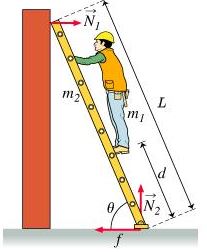Assignment:
A uniform ladder with mass m_2 and length L rests against a smooth wall. A do-it-yourself enthusiast of mass m_1 stands on the ladder a distance d from the bottom (measured along the ladder). The ladder makes an angle theta with the ground. There is no friction between the wall and the ladder, but there is a frictional force of magnitude f between the floor and the ladder. N_1 is the magnitude of the normal force exerted by the wall on the ladder, and N_2 is the magnitude of the normal force exerted by the ground on the ladder. Throughout the problem, consider counterclockwise torques to be positive. None of your answers should involve pi (i.e., simplify your trig functions).
A). Hat is the minimum coeffecient of static friction mu_min required between the ladder and the ground so that the ladder does not slip?
Express mu_min in terms of m_1, m_2, d, L, and theta.
B). Suppose that the actual coefficent of friction is one and a half times as large as the value of mu_min. That is, mu_{rm s} = (3/2)mu_{rm min}. Under these circumstances, what is the magnitude of the force of friction f that the floor applies to the ladder?
Express your answer in terms of m_1, m_2, d, L, g, and theta. Remember to pay attention to the relation of force and mu_s.
